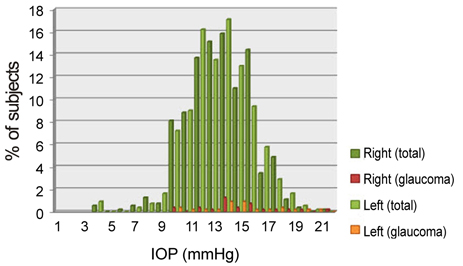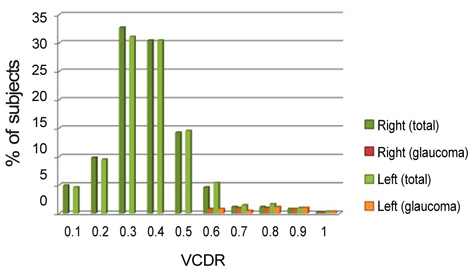Korean J Ophthalmol.
2011 Apr;25(2):110-115. 10.3341/kjo.2011.25.2.110.
Prevalence and Characteristics of Glaucoma among Korean Adults
- Affiliations
-
- 1Department of Ophthalmology, Institute of Vision Research, Yonsei University College of Medicine, Seoul, Korea. kcyeye@yuhs.ac
- 2Siloam Eye Hospital, Seoul, Korea.
- 3Noone Eye Hospital, Seoul, Korea.
- 4Department of Ophthalmology, Inha University School of Medicine, Incheon, Korea.
- KMID: 1111872
- DOI: http://doi.org/10.3341/kjo.2011.25.2.110
Abstract
- PURPOSE
The purpose of this study was to investigate the prevalence and characteristics of glaucoma in the population of the rural Korean town, Sangju.
METHODS
Residents of Sangju aged greater than 50 years old were included in this study. Participants completed an interview examining their medical and ophthalmic history Information was collected on the participants' uncorrected and best corrected vision scores, slit lamp examination results, angle width measurements using the Van Herick technique, gonioscopy if the angle width was less than 1 / 4 angle, intraocular pressure (IOP) assessed with the Goldmann applanation tonometry, optic disc examination results, and a visual field test results using frequency-doubling perimetry in cases in which glaucoma was suspected. Glaucoma was diagnosed according to the criteria described by the International Society for Geographic and Epidemiological Ophthalmology.
RESULTS
1,118 residents aged greater than 50 years were examined initially from a population of 2,984 people. Of these, 671 subjects (60%) participated in this study. The prevalence of glaucoma was determined to be 3.4% (95% confidence interval [CI], 2.1-4.8). Open-angle glaucoma with low IOP was determined to be the most common form with a prevalence rate as high as 2.5% (95% CI, 1.8-3.7). Additionally, primary angle closure glaucoma was determined to have a prevalence rate of 0.3% (95% CI, 0.1-0.9). Open-angle glaucoma with low IOP accounted for 94.4% of the open-angle glaucoma cases.
CONCLUSIONS
The prevalence of glaucoma among the population of rural Sangju was 3.4%, and open-angle glaucoma with low IOP was the most common form accounting for 94.4% of the total number of cases.
Keyword
MeSH Terms
Figure
Cited by 3 articles
-
Non-glaucomatous Retinal Nerve Fiber Layer Defect Associated with Paravascular Inner Retinal Defect
Gye Jung Kim, Dong Hwan Son, Jin-Soo Kim, Min Chul Shin
J Korean Ophthalmol Soc. 2020;61(2):214-220. doi: 10.3341/jkos.2020.61.2.214.Outpatient Distribution for Glaucoma Evaluation
Ka Hee Park, So Yeon Lee, Young Jae Hong
J Korean Ophthalmol Soc. 2015;56(3):388-395. doi: 10.3341/jkos.2015.56.3.388.Bilateral Delayed Nonarteritic Anterior Ischemic Neuropathy Following Acute Primary Angle-closure Crisis
Eun Jung Park, Yeoun Sook Chun, Nam Ju Moon
J Korean Ophthalmol Soc. 2018;59(11):1091-1096. doi: 10.3341/jkos.2018.59.11.1091.
Reference
-
1. Quigley HA, Broman AT. The number of people with glaucoma worldwide in 2010 and 2020. Br J Ophthalmol. 2006. 90:262–267.2. Rudnicka AR, Mt-Isa S, Owen CG, et al. Variations in primary open-angle glaucoma prevalence by age, gender, and race: a Bayesian meta-analysis. Invest Ophthalmol Vis Sci. 2006. 47:4254–4261.3. Iwase A, Suzuki Y, Araie M, et al. The prevalence of primary open-angle glaucoma in Japanese: the Tajimi Study. Ophthalmology. 2004. 111:1641–1648.4. Hong C, Joo JH, Shin KH, Song KY. Clinical study of Korean glaucomatous patients. Korean J Ophthalmol. 1987. 1:41–46.5. Shin SG, Ahn JH, Rho SH. A clinical analysis on 456 cases of glaucoma among outpatients during 5 years. J Korean Ophthalmol Soc. 1987. 28:1021–1026.6. Lee CK, Cho YJ, Hong YJ. Distribution of glaucoma outpatients. J Korean Ophthalmol Soc. 1995. 36:1020–1027.7. Lee JB, Cho YS, Choe YJ, Hong YJ. The prevalence of glanucoma in Korean adults. J Korean Ophthalmol Soc. 1993. 34:65–69.8. Choe YJ, Hong YJ. The prevalence of glaucoma in Korean careermen. J Korean Ophthalmol Soc. 1993. 34:153–158.9. Foster PJ, Buhrmann R, Quigley HA, Johnson GJ. The definition and classification of glaucoma in prevalence surveys. Br J Ophthalmol. 2002. 86:238–242.10. Medeiros FA, Sample PA, Weinreb RN. Frequency doubling technology perimetry abnormalities as predictors of glaucomatous visual field loss. Am J Ophthalmol. 2004. 137:863–871.11. Fogagnolo P, Mazzolani F, Rossetti L, Orzalesi N. Detecting glaucoma with frequency-doubling technology perimetry: a comparison between N-30 and C-20 screening programs. J Glaucoma. 2005. 14:485–491.12. Foster PJ, Baasanhu J, Alsbirk PH, et al. Glaucoma in Mongolia. A population-based survey in Hövsgöl province, northern Mongolia. Arch Ophthalmol. 1996. 114:1235–1241.13. Foster PJ, Oen FT, Machin D, et al. The prevalence of glaucoma in Chinese residents of Singapore: a cross-sectional population survey of the Tanjong Pagar district. Arch Ophthalmol. 2000. 118:1105–1111.14. Congdon NG, Quigley HA, Hung PT, et al. Screening techniques for angle-closure glaucoma in rural Taiwan. Acta Ophthalmol Scand. 1996. 74:113–119.15. He M, Foster PJ, Ge J, et al. Prevalence and clinical characteristics of glaucoma in adult Chinese: a population-based study in Liwan District, Guangzhou. Invest Ophthalmol Vis Sci. 2006. 47:2782–2788.16. Ramakrishnan R, Nirmalan PK, Krishnadas R, et al. Glaucoma in a rural population of southern India: the Aravind comprehensive eye survey. Ophthalmology. 2003. 110:1484–1490.17. Raychaudhuri A, Lahiri SK, Bandyopadhyay M, et al. A population based survey of the prevalence and types of glaucoma in rural West Bengal: the West Bengal Glaucoma Study. Br J Ophthalmol. 2005. 89:1559–1564.18. Dandona L, Dandona R, Srinivas M, et al. Open-angle glaucoma in an urban population in southern India: the Andhra Pradesh eye disease study. Ophthalmology. 2000. 107:1702–1709.19. Varma R, Ying-Lai M, Francis BA, et al. Prevalence of open-angle glaucoma and ocular hypertension in Latinos: the Los Angeles Latino Eye Study. Ophthalmology. 2004. 111:1439–1448.20. Quigley HA, West SK, Rodriguez J, et al. The prevalence of glaucoma in a population-based study of Hispanic subjects: Proyecto VER. Arch Ophthalmol. 2001. 119:1819–1826.21. Casson RJ, Newland HS, Muecke J, et al. Prevalence of glaucoma in rural Myanmar: the Meiktila Eye Study. Br J Ophthalmol. 2007. 91:710–714.22. Bourne RR, Sukudom P, Foster PJ, et al. Prevalence of glaucoma in Thailand: a population based survey in Rom Klao District, Bangkok. Br J Ophthalmol. 2003. 87:1069–1074.23. Yamamoto T, Iwase A, Araie M, et al. The Tajimi Study report 2: prevalence of primary angle closure and secondary glaucoma in a Japanese population. Ophthalmology. 2005. 112:1661–1669.24. Dandona L, Dandona R, Mandal P, et al. Angle-closure glaucoma in an urban population in southern India. The Andhra Pradesh eye disease study. Ophthalmology. 2000. 107:1710–1716.25. Vijaya L, George R, Arvind H, et al. Prevalence of angle-closure disease in a rural southern Indian population. Arch Ophthalmol. 2006. 124:403–409.26. Korean National Statistical Office Population Census Data. Available from http://kosis.kr/abroad/abroad_01List.jsp.27. Anderson AJ, Johnson CA. Frequency-doubling technology perimetry and optical defocus. Invest Ophthalmol Vis Sci. 2003. 44:4147–4152.28. Iwase A, Tomidokoro A, Araie M, et al. Performance of frequency-doubling technology perimetry in a population-based prevalence survey of glaucoma: the Tajimi study. Ophthalmology. 2007. 114:27–32.



